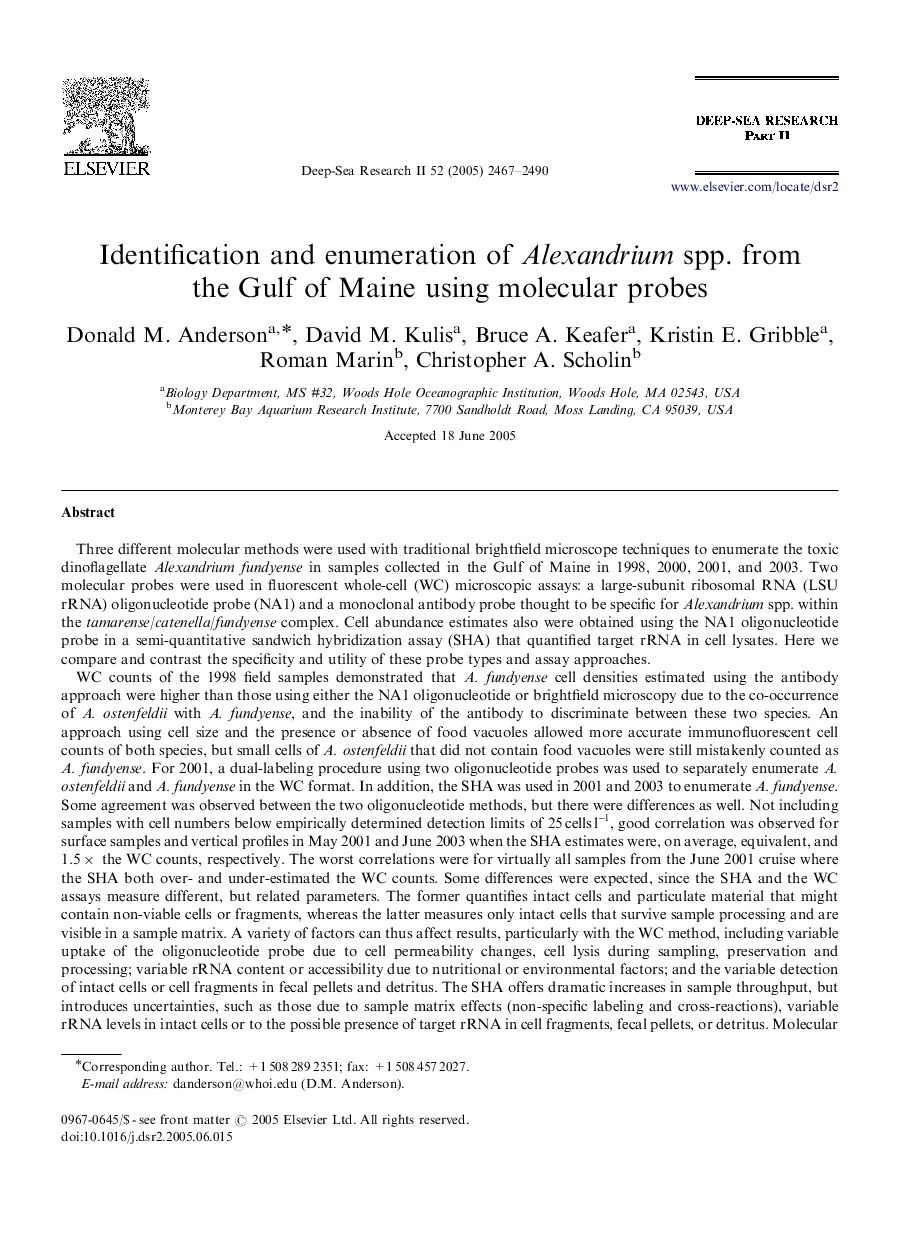| Article ID | Journal | Published Year | Pages | File Type |
|---|---|---|---|---|
| 4538578 | Deep Sea Research Part II: Topical Studies in Oceanography | 2005 | 24 Pages |
Three different molecular methods were used with traditional brightfield microscope techniques to enumerate the toxic dinoflagellate Alexandrium fundyense in samples collected in the Gulf of Maine in 1998, 2000, 2001, and 2003. Two molecular probes were used in fluorescent whole-cell (WC) microscopic assays: a large-subunit ribosomal RNA (LSU rRNA) oligonucleotide probe (NA1) and a monoclonal antibody probe thought to be specific for Alexandrium spp. within the tamarense/catenella/fundyense complex. Cell abundance estimates also were obtained using the NA1 oligonucleotide probe in a semi-quantitative sandwich hybridization assay (SHA) that quantified target rRNA in cell lysates. Here we compare and contrast the specificity and utility of these probe types and assay approaches.WC counts of the 1998 field samples demonstrated that A. fundyense cell densities estimated using the antibody approach were higher than those using either the NA1 oligonucleotide or brightfield microscopy due to the co-occurrence of A. ostenfeldii with A. fundyense, and the inability of the antibody to discriminate between these two species. An approach using cell size and the presence or absence of food vacuoles allowed more accurate immunofluorescent cell counts of both species, but small cells of A. ostenfeldii that did not contain food vacuoles were still mistakenly counted as A. fundyense. For 2001, a dual-labeling procedure using two oligonucleotide probes was used to separately enumerate A. ostenfeldii and A. fundyense in the WC format. In addition, the SHA was used in 2001 and 2003 to enumerate A. fundyense. Some agreement was observed between the two oligonucleotide methods, but there were differences as well. Not including samples with cell numbers below empirically determined detection limits of 25 cells l–1, good correlation was observed for surface samples and vertical profiles in May 2001 and June 2003 when the SHA estimates were, on average, equivalent, and 1.5× the WC counts, respectively. The worst correlations were for virtually all samples from the June 2001 cruise where the SHA both over- and under-estimated the WC counts. Some differences were expected, since the SHA and the WC assays measure different, but related parameters. The former quantifies intact cells and particulate material that might contain non-viable cells or fragments, whereas the latter measures only intact cells that survive sample processing and are visible in a sample matrix. A variety of factors can thus affect results, particularly with the WC method, including variable uptake of the oligonucleotide probe due to cell permeability changes, cell lysis during sampling, preservation and processing; variable rRNA content or accessibility due to nutritional or environmental factors; and the variable detection of intact cells or cell fragments in fecal pellets and detritus. The SHA offers dramatic increases in sample throughput, but introduces uncertainties, such as those due to sample matrix effects (non-specific labeling and cross-reactions), variable rRNA levels in intact cells or to the possible presence of target rRNA in cell fragments, fecal pellets, or detritus. Molecular probes are powerful tools for monitoring and research applications, but more work is needed to compare and refine these different cell enumeration methods on field samples, as well as to assess the general validity of brightfield or fluorescent WC approaches.
